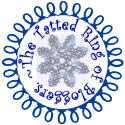Do you remember this
Hairpin Lace and Tatted Angel? It was the first pattern I shared with
Georgia's Online Class. (The directions are a little primitive compared to how I write now.)
Later update: Silly me, I forgot there's an updated, improved version right here on this blog. Just click on "Free Patterns" at the top of the page. Pardon me while I go sit in the corner and feel dumb for a while :)
This hairpin and tatted angel is one I taught at Palmetto Tatdays this past year.
I have several more elaborate hairpin and tatted angels in the works. Would you like to see a book of those?
The patterns are all based on "real" hairpin lace, made with a hairpin loom and a crochet hook. I really like hairpin lace. After the first fiddly bit getting started, it's quick to make and very neat and pretty. But maybe not everyone has a loom or wants to learn how. In planning for the possible book, I wondered about the option for substituting tatted mock hairpin lace for the real thing, so I did a comparison of different types. (If I had been paying attention, I would have noticed this had been covering in Georgia's class a few years ago. Go to the 2011 index
HERE and scroll down. )
Anyway, these are my results, all pieces 1 inch wide, and 15 loops per side, just as they came off the loom or shuttles without blocking.
1. This is regular crocheted basic braid hairpin lace, made with one single crochet stitch per loop, with a size 6 hook, I think. (Single crochet in American crochet terminology. I think it is a double crochet in British terminology.)
2. This is tatting: [2 first half stitches, picot, 2 second half stitches, picot] repeat. It's about the right size. It's a little messy, but might look neater once the rest of the angel is tatted onto it.
3. Tatting half stitches like number 2, but with 3 half stitches between picots. Not as messy, but maybe too wide.
4. This one is a pearl tatted chain, alternating 1 ds on each side, with long picots in between. It's a little longer than the real HPL, but might do.
5. This is a method shared by Ruth Perry with the Online Class
HERE. It is basically {[half stitch, picot, ds all flipped][half stitch, picot, ds all unflipped]} repeat. It makes the neatest of the tatted mock HPL braids, but much too long for the patterns I am working on.
6. I have seen this one in several places. It is made up of {[picot, ds flipped] [picot, ds unflipped]} repeat. Not as long as Ruth's, but still too long for my purpose.
7. This is another "true" crocheted HPL, but with a difference. In the book, Hairpin Crochet, Technique and Design, by Pamela Thompson, she makes a different sort of basic braid. Unlike the basic braids in other books I've consulted, she works 1 sc plus a chain stitch per loop. So this makes a HPL braid with similar dimensions to some of the tatted mock HPL. Maybe useful for substituting a crocheted braid into a tatted braid pattern.
8. Not pictured. There are several patterns where a strip of small split rings with a long picot on each side is used for a HPL like effect. Some very pretty patterns, but again, very long for the number of loops.
CONCLUSION: There are many sorts of Hairpin lace braids, both traditional and tatted mock versions. If you are working a pattern using HPL, be sure you are aware which version the pattern is using. Be very careful with substituting one style for another.





















.jpg)


































